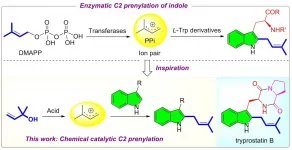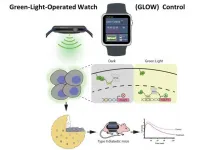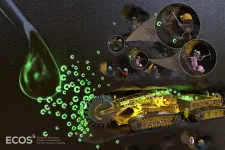COVID-19 as systemic disease: What does that mean for kidneys?
COVID-19 and the kidneys
2021-06-07
(Press-News.org) It was clear at a relatively early stage of the pandemic that SARS-CoV-2 causes a wide range of symptoms; in addition to typical respiratory symptoms, patients also had neurological symptoms (starting with anosmia), gastrointestinal symptoms, elevated liver values, and renal, urinary or hematological changes, for example. The fact that such findings occurred not only in severely ill patients with general organ dysfunction suggested that the virus may potentially cause disorders in various organs directly, i.e. that it causes a multi-system disease.
In spring 2020, at the very beginning of the pandemic, the authorities in Hamburg ordered autopsies be performed on all patients who had died with COVID-19. This resulted in one of the world's largest autopsy databases in which data on all organ systems were gathered. The autopsies carried out by forensic pathologists in Hamburg have provided the basis for many organ-related COVID-19 research projects.
One of last year's most frequently cited nephrologic studies, led by Prof. Tobias Huber, UKE Hamburg, showed [1] that the viral load (measured as the number of copies per cell) in the deceased was highest in the respiratory tract and second highest in the kidneys, followed by lower levels in heart and liver, brain and blood. Old age and the number of comorbidities, above all, were associated with multi-organ and renal tropism.
All in all, the Hamburg studies indicate that the diversity of symptoms in SARS-CoV-2 infections might also be related to the wide range of organs infected by the virus.
Association of SARS-CoV-2 organotropism with acute kidney damage
Compared to other intensive care patients with severe infections or sepsis, COVID-19 patients have a significantly higher rate of acute kidney injury (AKI) (56.9% versus 37.2%) [10]. Renal replacement therapy is required by 4.9%, compared to 1.6%. A study [3] of 5,216 US veterans with COVID-19 showed an average AKI incidence of 32%, which means that one in three developed acute kidney injury. 12% needed kidney replacement therapy (dialysis), and nearly half (47%) of the patients had not recovered renal function by discharge. "These are dramatic figures", explained Professor Tobias Huber, UKE Hamburg, at the Opening Press Conference of the 2021 ERA-EDTA Congress. "We know from major AKI studies that some patients whose kidney function does not recover after AKI subsequently transition to chronic kidney disease."
AKI was associated with the risk of mechanical ventilation (OR 6.46), the risk of mortality (OR 6.71) and prolonged in-patient treatment (OR 5.56). Predictors of acute kidney failure were age, obesity, diabetes mellitus, hypertension, restriction of kidney function (lower filtration rate/ eGFR), male gender and Afro-American descent.
Another major autopsy study conducted by Prof. Huber's team in Hamburg [4] explored the hypothesis that renal tropism may be independently correlated with outcome. In 63 autopsies with a similarly high comorbidity rate as in other studies, the virus was directly detected in the kidneys of 60% of the cases. This also correlated with age, number of coexisting diseases and male gender. The time interval between COVID-19 diagnosis and date of death was significantly shorter when the virus was detectable in the kidneys (approx. 14 versus 21 days). Renal tropism was also associated with the incidence of acute kidney injury: Of a total of 40 patients, seven had no AKI (three of the seven having renal viral infection), compared to 33 patients with AKI (23 of the 33 having virus detected in the kidney). The virus was isolated from tubule cells of autopsied kidney tissue, and subsequent cell infection experiments showed that the viruses were active and capable of replication, increasing a thousand-fold in 48 hours.
Together these studies identified SARS CoV-2 as a multi-tropic virus with affinity for the kidney potentially explaining why kidney injury is so frequently occurring in COVID-19 patients.
INFORMATION:
[1] Victor G Puelles, Marc Lütgehetmann, Maja T Lindenmeyer et al. Multiorgan and Renal Tropism of SARS-CoV-2. N Engl J Med 2020; 383 (6): 590-592
[2] Alexis Werion, Leila Belkhir , Marie Perrot et al. SARS-CoV-2 causes a specific dysfunction of the kidney proximal tubule. Kidney Int 2020; 98 (5): 1296-1307
[3] Benjamin Bowe, Miao Cai, Yan Xie et al. Acute Kidney Injury in a National Cohort of Hospitalized US Veterans with COVID-19. Clin J Am Soc Nephrol 2020; 16 (1): 14-25
[4] Fabian Braun, Marc Lütgehetmann, Susanne Pfefferle et al. SARS-CoV-2 renal tropism associates with acute kidney injury. Lancet 2020; 396 (10251): 597-598
ERA-EDTA Press Office
Dr Bettina Albers
Tel. +49 3643 7764-23/mobile +49 174 2165629
email: press@era-edta.org
ELSE PRESS RELEASES FROM THIS DATE:
2021-06-07
Various viruses and bacteria have long been known to cause autoimmune diseases where there is such a predisposition. This phenomenon also seems to play a major role in SARS-CoV-2, especially in severe courses. The body's own immune cells are activated, with the formation of autoantibodies that attack the body's own healthy cell structures (proteins, autoantigens); deposits of immune complexes can then trigger severe inflammatory processes and cell destruction in the body.
Some nephrological diseases are likewise of autoimmunological etiology, one example being systemic lupus erythematosus (SLE), a chronic, mostly relapsing-remitting inflammatory disease with life-threatening ...
2021-06-07
Terpenoids are omnipresent in almost all living organisms. Prenylated indoles are prominent representatives that usually display potent medicinal properties (e.g. tryprostatin B). Therefore, significant efforts have been devoted to indole prenylation over the past decades. The known protocols often require a multi-step procedure and rely on the use of stoichiometric promoters. From the viewpoint of step- and atom-economy, developing a direct catalytic C2 prenylation of indoles is highly desirable yet challenging, because the nucleophilicity of C2 site is weaker than that of other two positions ...
2021-06-07
Consuming large amounts of daily caffeine may increase the risk of glaucoma more than three-fold for those with a genetic predisposition to higher eye pressure according to an international, multi-center study. The research led by the Icahn School of Medicine at Mount Sinai is the first to demonstrate a dietary - genetic interaction in glaucoma. The study results published in the June print issue of Ophthalmology may suggest patients with a strong family history of glaucoma should cut down on caffeine intake.
The study is important because glaucoma is the leading cause of blindness in the United States. It looks at the impact of caffeine intake on glaucoma, ...
2021-06-07
Research Highlights:
Rates of Kawasaki disease - a condition that creates inflammation in blood vessels in the heart and is more common in children of Asian/Pacific Island descent - have substantially decreased in South Korea during the COVID-19 pandemic.
The decrease could be due to mask-wearing, hand-washing, school closures and physical distancing, suggesting Kawasaki disease may be prompted by infectious agents.
The cause of Kawasaki disease is unknown, though it may be an immune response to acute infectious illness.
DALLAS, June 7, 2021 -- The rate of Kawasaki disease in South Korea has substantially decreased during the COVID-19 pandemic, possibly due to pandemic prevention efforts, such as mask-wearing, ...
2021-06-07
CAMBRIDGE, MA -- MIT engineers have discovered a new way of generating electricity using tiny carbon particles that can create a current simply by interacting with liquid surrounding them.
The liquid, an organic solvent, draws electrons out of the particles, generating a current that could be used to drive chemical reactions or to power micro- or nanoscale robots, the researchers say.
"This mechanism is new, and this way of generating energy is completely new," says Michael Strano, the Carbon P. Dubbs Professor of Chemical Engineering at MIT. "This technology is intriguing because all you have to do is flow a solvent through a bed of these particles. ...
2021-06-07
Many modern fitness trackers and smartwatches feature integrated LEDs. The green light emitted, whether continuous or pulsed, penetrates the skin and can be used to measure the wearer's heart rate during physical activity or while at rest.
These watches have become extremely popular. A team of ETH researchers now wants to capitalise on that popularity by using the LEDs to control genes and change the behaviour of cells through the skin. The team is led by Martin Fussenegger from the Department of Biosystems Science and Engineering in Basel. He explains the challenge to this undertaking: "No naturally occurring molecular ...
2021-06-07
Levels of a protein called neurofilament light chain (NfL) in the blood can identify those who might have neurodegenerative diseases such as Down's syndrome dementia, motor neuron disease (ALS) and frontotemporal dementia, when clinical symptoms are not definitive.
Published in Nature Communications and part-funded by the NIHR Maudsley Biomedical Research Centre, the research determined a set of age-related cut-off levels of NfL which could inform its potential use in primary care settings through a simple blood test.
Joint Senior Author on the study, Dr Abdul Hye from the NIHR Maudsley Biomedical Research Centre at King's College London and South London and Maudsley NHS Foundation Trust said: 'For the first time we have shown ...
2021-06-07
The first double-blind experiment analysing the role of human decision-making in climate reconstructions has found that it can lead to substantially different results.
The experiment, designed and run by researchers from the University of Cambridge, had multiple research groups from around the world use the same raw tree-ring data to reconstruct temperature changes over the past 2,000 years.
While each of the reconstructions clearly showed that recent warming due to anthropogenic climate change is unprecedented in the past two thousand years, there were notable differences in variance, amplitude and sensitivity, ...
2021-06-07
NEW YORK, June 7, 2021--Recent studies suggest that new brain cells are being formed every day in response to injury, physical exercise, and mental stimulation. Glial cells, and in particular the ones called oligodendrocyte progenitors, are highly responsive to external signals and injuries. They can detect changes in the nervous system and form new myelin, which wraps around nerves and provides metabolic support and accurate transmission of electrical signals. As we age, however, less myelin is formed in response to external signals, and this progressive decline has been linked to the age-related cognitive and motor deficits detected in older people in the general population. Impaired ...
2021-06-07
Just a few bacterial taxa found in ecosystems across the planet are responsible for more than half of carbon cycling in soils. These new findings, made by researchers at Northern Arizona University and published in END ...
LAST 30 PRESS RELEASES:
[Press-News.org] COVID-19 as systemic disease: What does that mean for kidneys?
COVID-19 and the kidneys


